| home > report on operations > financial position > review of balance sheet, income statement and financial position |
home > report on operations > financial position > review of balance sheet, income statement and financial position
review of balance sheet, income statement and financial position
Income Statement
The Parent Company Income Statement
for 2010 recorded a net loss of 128.5
million euros, against a loss of 79.9
million euros in 2009.
Following the merger by incorporation
of the subsidiary RaiSat into Rai, which
took place during the year, backdating
the accounting effects to 1 January
2010, in order to ensure a fair
comparison of this year's results with
those of last year, an Income Statement
and a Balance Sheet resulting from the
consolidation of the two companies, as
highlighted by the reclassified statements
presented at the side, have been drawn
up for reference.
The 2009 Income Statement drawn up
in this way shows a loss of 81.3 million
euros.
The following section provides an
overview of the main items of the
Income Statement and the reasons
behind the more significant changes
from the figures of the previous year, as
defined above.
Revenues from sales and services
Revenues from sales and services consist
of licence fees, advertising revenues and
other commercial revenues.
They totalled 2,821.0 million euros,
down 171.2 million euros (-5.7%) on
2009.
Licence fees (1,685.4 million euros).
These include licence fees for the
current year as well as those for
previous years, collected through
coercive payment following legal
registration.
They also include accounts receivable
from the Ministry of the Economy and
Finance for unpaid licence fees relating
to 2008, 2009 and 2010 for
subscribers exempted from payment,
pursuant to art. 1 paragraph 132, law
no. 244 of 24 December 2007.
It should be pointed out that circular
46/E, dated 20 September 2010, in
defining the subjective requirements
and the procedure that the parties
concerned have to observe to take
advantage of such benefit, the Inland
Revenue Department established the
necessary basis for identifying those
entitled to exemption. The
identification of expected subscribers,
which is now in the advanced stages,
has made it possible to prudentially
estimate an account receivable of 2.0
million euros.

The overall increase (+2.4%) refers to
the increase in the per-unit licence fee
from 107.50 euros to 109.00 euros
(+1.4%), and the marked increase in
measures to coerce payment. There has
also been an increase in the number of
paying subscribers (+0.2%) and the
recovery of new subscribers (+3.4%),
following a decline in 2009.
Once again in 2010 the licence fee
paid in Italy continues to be one of the
lowest in Europe. By way of example,
the table shows the annual licence fee,
in euros, in force in the most important
European countries.
Advertising revenues. As soon as the
first timid signs of recovery from
recession began to appear, the
national advertising market showed a
reversal of the trend for 2009, and
presented moderate but widespread
signs of recovery for almost every
medium and sector: the advertising
market presents growth of 3.8% in
2010, increasing revenue by about
300 million euros. With the exception
of Periodicals and Daily Newspapers,
all media have shown a positive trend.
The Rai reference market (TV and
Radio) showed an overall increase of
6.1% (source Nielsen) in 2010.
In this context, Rai's advertising
revenues (942.4 million euros)
highlight an increase of 31.0 million
euros (+3.4%) compared with 2009.
The growth of the specialised channels
should be noted, as they recorded a
considerable increase in viewers
compared with 2009, due to the high
quality of programming, the expansion
of the DTT signal broadcasting area
and actions for the repositioning and
rebranding of certain channels (Rai
Movie and Rai 5).

Other revenues
present a reduction
of 242.2 million euros (-55.6%),
determined mainly by the absence of
the income booked in 2009 for the
sale to third parties of the pay TV
broadcasting rights for the 2010 and
2014 World Cups and for other minor
FIFA events, for the sum of 175 million
euros. Other reductions of the caption
are highlighted in the table at the side.
They comprise the zeroing of income
from the Supply of theme-based
satellite channels by former RaiSat
(-32.7 million euros), the reduction of
the Sale of rights to the utilise archive materials to football clubs (-13.3
million euros) for the different effects
of the agreements entered into during
the two years, Special services under
agreement (-10.0 million euros) as a
consequence of the reorganisation of
activities envisaged under the foreign
broadcasting agreement, Services
rendered to telephone companies (-
7.1 million euros) and Different
services, performed mainly for public
entities (-6.9 million euros) including
lower income from the Ministry of
Education, University and Research
(5.5 million euros in 2009).
As shown in the table on the right, the
relative weights of the three components
on total revenues from sales and
services show an increase in the Licence
Fees and Advertising items compared
with the totals for the previous year, to
the detriment of the Other revenues
component.
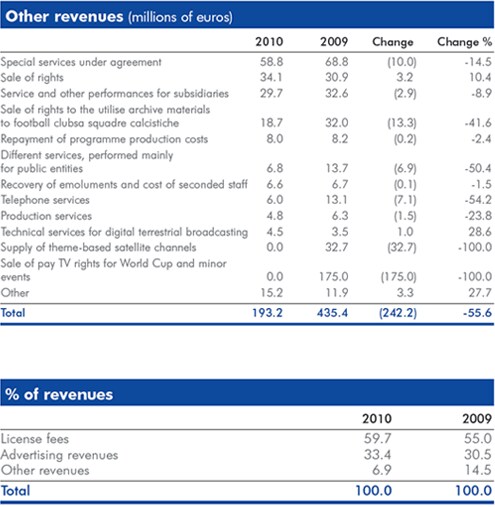
Operating costs
These total 2,649.9 million euros,
falling 101.4 million euros, -3.7%,
compared with 2009, as detailed below.
The item includes internal costs (labour
cost) and external costs, regarding
ordinary business activities, according to
the following classification.
Consumption of goods and external
services- This caption includes
purchases of goods and services
required to make programmes of
immediate use (purchases of
consumables, external services, artistic
collaborations, etc), filming rights for
sports events, copyright, services from
subsidiaries, running costs (rental and
hire fees, telephone and postage costs,
cleaning, maintenance, etc.) and other
operating costs (direct and indirect
taxes, contribution to the Authority, the
public broadcasting concession fee,
etc.).
As shown in the table, the caption
shows a drop of 102.3 million euros
(-5.6%), determined by the absence of
the cost of pay TV broadcasting rights
for the 2010 and 2014 World Cups
and for other minor FIFA events, for
169.3 million euros, subject to the sale
to third parties booked last year and
mentioned earlier.
The comparison, net of this component,
highlights an increase in the caption of
67.0 million euros (+3.6%), largely
deriving from the increase in costs to
purchase broadcasting rights mainly for
sports events (+77.2 million euros). As
in all even numbered years, 2010 was
characterised by important four-yearly
sports events (World Cup and Winter
Olympics) influencing the 2010 income
statement by 107.8 million euros,
partially offset by savings from the
broadcasting rights for the Champions
League and Italian National Football
Team matches.
In addition to the above, higher costs
for activities performed by Group
companies and savings in other
components of the caption are
highlighted, confirming a trend which
had already characterised last year.
The higher costs for activities performed
by Group companies refer to Rai Way
(+19.9 million euro), mainly for the
extension of broadcasting and
transmission of the DTT signal, and to
Rai Cinema (+19.0 million euro) for the
considerable growth in the use of high
quality TV series.
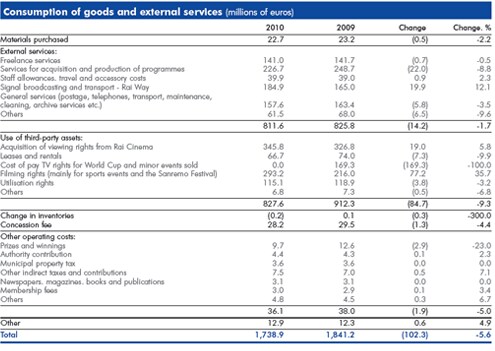
Personnel costs
- These amount to
911.0 million euros, up by a total of
0.9 million euros on the total at 31
December 2009 (+0.1%), as detailed
in the right-hand table.

Personnel costs are in line with the level
for last year, thanks partially to the
absence of provision for middle
management, office staff, blue collar
and executive bonuses, resulting in a
lower cost of about 16 million euros.
The reduction in personnel costs is also
due to a series of management
measures to offset the economic impact
of automatic pay increases provided for
by the labour contract, the stabilisation
of those on temporary employment
contracts, the rise in the staff severance
pay revaluation index and, above all,
the simultaneous renewal of all the
collective contracts.
Among the actions taken, incentives for
resignation and the substantial blockage
of management policies played a
significant role.
Personnel on payroll at 31 December
2010 amounted to 10,055 units, up 25
on 31 December 2009.
The average number of employees,
including those on fixed-term contracts,
came to 11,857, with a reduction of 61
members of staff compared to last year.
In detail, there has been a drop of 178
members of staff on fixed-term contracts
following stabilisation, corresponding to
a growth of 117 members of staff on
permanent contracts due to the
simultaneous resignation incentives.
Gross Operating Margin
The Gross Operating Margin, as a
consequence of the above, is positive
for 185.3 million euros, down 71.0
million euros, or 27.7%, on the previous
year.
Amortisation of programmes
This caption is related to investments
in programmes, which during 2010
amounted to 272.9 million euros, down
31.4 million euros (-10.3%), mainly due
to TV fiction series.

Amortisation charged to the above
captions for the year, 257.4 million
euros, shows a reduction of 19.6
million euros (-7.1%) compared with the
previous year, related to the
performance of investments.

Other amortisation
This is linked to investments in tangible
non-current assets and other
investments, the movements of which
during 2010, highlighted in the
following table, present an overall
reduction of 14.6 million euros.

Depreciation and amortisation
charged for the year in relation to the
above captions amount to 68.0 million
euros, with a drop of 10.3 million euros
compared with 2009, referring entirely
to tangible non-current assets, in
relation to the progressive completion of
the amortisation of assets acquired in
the past, in the presence of a contained
level of investment.

Other net income (charges)
The caption comprises costs/revenues
not directly related to the Company's
core business and, in 2010, highlights
net charges of 20.2 million euros (35.4
million euros in the previous year). In
detail, it comprises provisions for risks
and charges (15.9 million euros),
expenses for repeat-usage programmes
which it is not expected will be used or
repeated (34.7 million euros), provision
for the company supplementary pension
fund for former employees (9.7 million
euros), partially offset by net prior-year
income (25.0 million euros) and the
release of funds allocated in previous
years (16.4 million euros).
Operating Result
The results described above for
operating revenues and costs led to a
deterioration in the operating result,
from -134.4 million euros in the
previous year to -160.3 million euros
this year, with a drop of 25.9 million
euros.
Net financial income
Net financial income shows a gain of
1.9 million euros (1.0 million euros in
2009). The caption shows the economic
effects of typical financial operations
and comprises bank interest expense
and income as well as that relating to
Group companies and net income in
relation to exchange rates.
The details show a drop in net interest
payable to banks of 0.3 million euros
against higher financial exposure to
third parties, partly offset by a reduction
in the rates applied. Low market interest
rates also determined a limited
reduction (0.5 million euros) in interest
income from the loan to the associated
companies.
Exchange rate differences, mainly
generated by the acquisition of rights to
sports events in US dollars, were positive
thanks to hedging activities carried out
in previous years, which limited the
negative performance of the euro/dollar
exchange rate during the year.
The average cost of loans with banks
and other financial institutions, made up
of credit lines on current accounts, 'hot
cash' and stand-by loans, dropped in
relation to the reduction in the money
market reference rates, settling at 1.9%
(2.3% in the previous year).

Income from equity investments
As indicated in the table below, the
caption amounts to a total of 59.8
million euros and includes the dividends
collected in the period considered valid
for the results of the previous year (57.6
million euros), the capital gain
measured at the end of the liquidation
process of the subsidiary Sacis (4.8
million euros), the reductions of the
value of equity investments for losses
totalled during the year (3.1 million
euros).
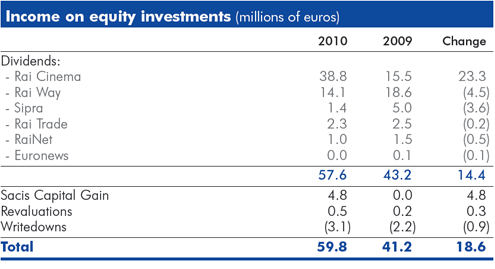
Net exceptional expense
This caption amounts to 45.0 million
euros (1.6 million euros in 2009)
originated by expenses for incentivised
early staff resignation.
Income taxes
The caption has a positive value of 15.1
million euros, determined by the
balance between current and deferred
taxes, as detailed in the table.
As regards the IRES tax, no amount was
booked as the year's result for tax
purposes was negative.
IRAP, amounting to 25.6 million euros,
shows a decrease of 1.9 million euros
compared with the previous year,
determined by a lower taxable
amount.
Deferred tax liabilities determine a
positive effect of 2.7 million euros (13.8
million euros in 2009), as a
consequence of the reversal of the
temporary differences of income deriving
from the higher amortisation applied in
previous years for tax purposes only.
Deferred tax assets (38.0 million euros)
originated from the booking of IRES
credits for 37.7 million euros, deriving
from the year's negative taxable
income, which is offset by the positive
taxable income of subsidiaries, included
within the scope of the tax consolidation
mechanism for tax year 2010.

Balance sheet
Non-current assets

Tangible non-current assets
are detailed in the right-hand table.

Investments in programmes
are mainly represented by TV fiction series
(345.3 million euros), which accounted
for the greater part of investments
during the year (272.9 million euros).
Details in the right-hand table.

Equity investments
improved slightly
(+3.2 million euros) largely due to the
recapitalisation of Rai World.
Other non-current assets
are shown in the right-hand table.
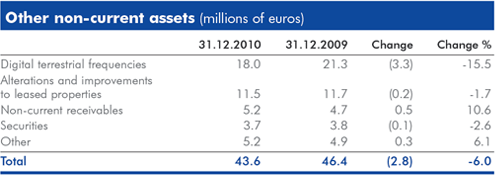
Working capital
The change from 2009 (-81.4 million
euros) is due mainly to normal
developments in the business.
Major changes relate to:
• Trade receivables:
down 106.5 million euros, owing mainly to
collection during the year of prior
amounts receivable for services
rendered to the Government under
contract.
• Other assets:
down 32.9 million
euros largely due to the re-entry of
advance payments made to purchase
the broadcasting rights for sports
events held during the year
(particularly the World Cup and
Winter Olympics).
• Other liabilities:
down 41.3 million
euros, determined mainly by the
different temporary liquidation of
various accounts payable.
It should be noted that Trade
receivables comprise, net of the
relative writedowns, accounts receivable
from subsidiaries, mainly Sipra, and
from public entities and institutions.
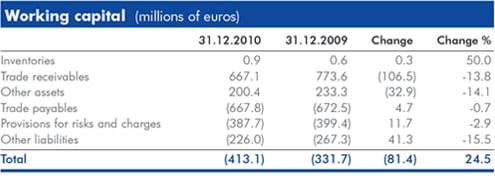
Net financial position
The year-end net financial position is
positive, despite the decline compared
to the previous year (3.8 million euros
compared with 40.5 million euros in
2009), and is comprised as follows:

Despite the negative economic result,
the overall financial position highlights a
limited decrease (36.7 million euros)
which can be attributed entirely to the
intercompany component, particularly
for the deterioration of the balance with
Rai Cinema.
The improvement in working capital,
mainly due to the collection of prior
accounts receivable for the services
rendered to the Government under
contract, and the reduction of the total
investments made, contributed
significantly to this result.
The net financial position is positive,
despite dropping slightly compared with
the previous year (from 59 to 53 million
euros).
The analysis carried out on the basis of
the balance sheet and income
statement ratios highlighted that:
The financial risks to which the
Company is exposed are monitored
using appropriate computerised and
statistical instruments. A policy regulates
financial management in accordance
with best international practice, the aim
being to preserve the corporate value by
taking an adverse attitude towards risk,
pursued via active monitoring of the
exposure and the implementation of
suitable hedging strategies, also acting
on behalf of the Group companies.
In particular:
           |
 |